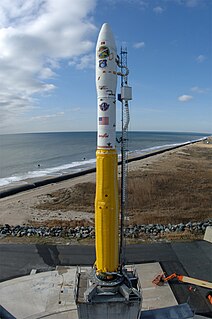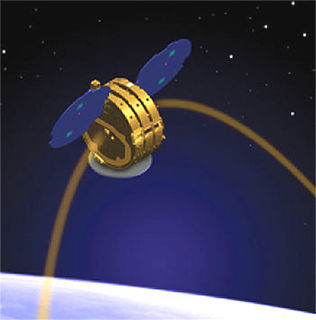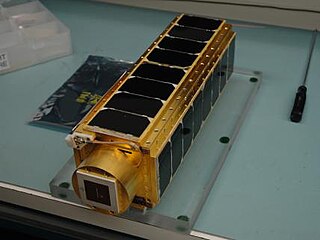This article includes a list of references, related reading or external links, but its sources remain unclear because it lacks inline citations .(March 2015) (Learn how and when to remove this template message) |
| Mission type | Technology |
|---|---|
| Operator | HISS |
| COSPAR ID | 2009-028D |
| SATCAT no. | 35004 |
| Spacecraft properties | |
| Spacecraft type | 1U CubeSat |
| Manufacturer | Pumpkin Incorporated |
| Start of mission | |
| Launch date | 19 May 2009, 23:55 UTC |
| Rocket | Minotaur I |
| Launch site | MARS LP-0B |
| Contractor | Orbital |
| Orbital parameters | |
| Reference system | Geocentric |
| Regime | Low Earth |
HawkSat I is a single-unit CubeSat which was built and is being operated by the Hawk Institute for Space Sciences. It is based on a Pumpkin Incorporated CubeSat kit, and carries a technology demonstration payload, primarily as a proof-of-concept mission, testing command, data and power subsystems, as well as solar panels and communications.

A CubeSat is a type of miniaturized satellite for space research that is made up of multiples of 10 cm × 10 cm × 11.35 cm cubic units. CubeSats have a mass of no more than 1.33 kilograms (2.9 lb) per unit, and often use commercial off-the-shelf (COTS) components for their electronics and structure. CubeSats are commonly put in orbit by deployers on the International Space Station, or launched as secondary payloads on a launch vehicle. Over 1000 CubeSats have been launched as of January 2019. Over 900 have been successfully deployed in orbit and over 80 have been destroyed in launch failures.

Photovoltaic solar panels absorb sunlight as a source of energy to generate direct current electricity. A photovoltaic (PV) module is a packaged, connected assembly of photovoltaic solar cells available in different voltages and wattages. Photovoltaic modules constitute the photovoltaic array of a photovoltaic system that generates and supplies solar electricity in commercial and residential applications.
It also carries a commercial material exposure research payload for an undisclosed "major aerospace company", which exposes a number of material samples to space, and records the effects of exposure on the materials. Experimental data will be returned to Earth by means of a store and dump communications system.
It was successfully launched on an Orbital Sciences Corporation Minotaur I rocket from Pad 0B at the Mid-Atlantic Regional Spaceport, at 23:55 GMT on 19 May. It was a tertiary payload, with TacSat-3 as the primary payload and PharmaSat as the secondary. Two other CubeSats, AeroCube 3 and CP6, were launched on the same rocket, and together the three satellites are known as the CubeSat Technology Demonstration mission.
Orbital Sciences Corporation was an American company specializing in the design, manufacture and launch of small- and medium- class space and rocket systems for commercial, military and other government customers. In 2014 Orbital merged with Alliant Techsystems to create a new company called Orbital ATK, Inc., which in turn was purchased by Northrop Grumman in 2018. Orbital Sciences Corporation today is a subsidiary of Northrop Grumman and is known as Northrop Grumman Innovation Systems.

The Minotaur I, or just Minotaur is an American expendable launch system derived from the Minuteman II missile. It is used to launch small satellites for the US Government, and is a member of the Minotaur family of rockets produced by Orbital Sciences Corporation.

Launch Pad 0, Pad 0 or LP-0, also known as Launch Complex 0, Launch Area 0 or LA-0, is a launch complex at the Mid-Atlantic Regional Spaceport (MARS) on Wallops Island, Virginia in the United States. MARS is located adjacent to NASA's Wallops Flight Facility (WFF), which ran the launch complex until 2003. WFF continues to provide various support services to MARS launches under contract with the Commonwealth of Virginia.










